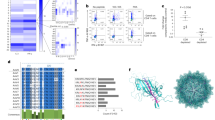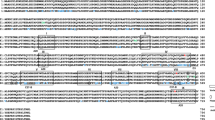Abstract
The high prevalence of human serum antibodies against adeno-associated virus type 2 (AAV) vectors represents a potential limitation for in vivo applications. Consequently, the development of AAV vectors able to escape antibody binding and neutralization is of importance. To identify capsid domains which contain major immunogenic epitopes, six AAV capsid mutants carrying peptide insertions in surface exposed loop regions (I-261, I-381, I-447, I-534, I-573, I-587) were analyzed. Two of these mutants, I-534 and I-573, showed an up to 70% reduced affinity for AAV antibodies as compared to wild-type AAV in the majority of serum samples. In addition, AAV mutant I-587 but not wild-type AAV efficiently transduced cells despite the presence of neutralizing antisera. Taken together, the results show that major neutralizing effects of human AAV antisera might be overcome by the use of AAV capsid mutants.
This is a preview of subscription content, access via your institution
Access options
Subscribe to this journal
Receive 12 print issues and online access
$259.00 per year
only $21.58 per issue
Buy this article
- Purchase on Springer Link
- Instant access to full article PDF
Prices may be subject to local taxes which are calculated during checkout






Similar content being viewed by others
References
Snyder RO et al. Persistent and therapeutic concentrations of human factor IX in mice after hepatic gene transfer of recombinant AAV vectors. Nat Genet 1997; 16: 270–276.
Russell DW, Kay MA . Adeno-associated virus vectors and hematology. Blood 1999; 94: 864–874.
Halbert CL et al. Repeat transduction in the mouse lung by using adeno-associated virus vectors with different serotypes. J Virol 2000; 74: 1524–1532.
Kaplitt MG et al. Long-term gene expression and phenotypic correction using adeno-associated virus vectors in the mammalian brain. Nat Genet 1994; 8: 148–154.
Flotte TR et al. Stable in vivo expression of the cystic fibrosis transmembrane conductance regulator with an adeno-associated virus vector. Proc Natl Acad Sci USA 1993; 90: 10613–10617.
Fisher-Adams G et al. Integration of adeno-associated virus vectors in CD34+ human hematopoietic progenitor cells after transduction. Blood 1996; 88: 492–504.
Xiao X, Li J, Samulski RJ . Efficient long-term gene transfer into muscle tissue of immunocompetent mice by adeno-associated virus vector. J Virol 1996; 70: 8098–8108.
Summerford C, Samulski RJ . Membrane-associated heparan sulfate proteoglycan is a receptor for adeno-associated virus type 2 virions. J Virol 1998; 72: 1438–1445.
Qing K et al. Human fibroblast growth factor receptor 1 is a co-receptor for infection by adeno-associated virus 2. Nat Med 1999; 5: 71–77.
Summerford C, Bartlett JS, Samulski RJ . AlphaVbeta5 integrin: a co-receptor for adeno-associated virus type 2 infection. Nat Med 1999; 5: 78–82.
Qiu J, Mizukami H, Brown KE . Adeno-associated virus 2 co-receptors? Nat Med 1999; 5: 467–468.
Qiu J, Brown KE . Integrin alphaVbeta5 is not involved in adeno-associated virus type 2 (AAV2) infection. Virology 1999; 264: 436–440.
Bartlett JS, Wilcher R, Samulski RJ . Infectious entry pathway of adeno-associated virus and adeno-associated virus vectors. J Virol 2000; 74: 2777–2785.
Duan D et al. Dynamin is required for recombinant adeno-associated virus type 2 infection. J Virol 1999; 73: 10371–10376.
Douar AM, Poulard K, Stockholm D, Danos O . Intracellular trafficking of adeno-associated virus vectors: routing to the late endosomal compartment and proteasome degradation. J Virol 2001; 75: 1824–1833.
Sanlioglu S et al. Endocytosis and nuclear trafficking of adeno-associated virus type 2 are controlled by rac1 and phosphatidylinositol-3 kinase activation. J Virol 2000; 74: 9184–9196.
Seisenberger G et al. Real-time single-molecule imaging of the infection pathway of an adeno-associated virus. Science 2001; 294: 1929–1932.
Kronenberg S, Kleinschmidt JA, Bottcher B . Electron cryo-microscopy and image reconstruction of adeno-associated virus type 2 empty capsids. EMBO Rep 2001; 2: 997–1002.
Xie Q et al. The atomic structure of adeno-associated virus (AAV-2), a vector for human gene therapy. Proc Natl Acad Sci USA 2002; 99: 10405–10410.
Rabinowitz JE, Xiao W, Samulski RJ . Insertional mutagenesis of AAV2 capsid and the production of recombinant virus. Virology 1999; 265: 274–285.
Wu P et al. Mutational analysis of the adeno-associated virus type 2 (AAV2) capsid gene and construction of AAV2 vectors with altered tropism. J Virol 2000; 74: 8635–8647.
Wobus CE et al. Monoclonal antibodies against the adeno-associated virus type 2 (AAV-2) capsid: epitope mapping and identification of capsid domains involved in AAV-2-cell interaction and neutralization of AAV-2 infection. J Virol 2000; 74: 9281–9293.
Erles K, Sebokova P, Schlehofer JR . Update on the prevalence of serum antibodies (IgG and IgM) to adeno- associated virus (AAV). J Med Virol 1999; 59: 406–411.
Chirmule N et al. Immune responses to adenovirus and adeno-associated virus in humans. Gene Therapy 1999; 6: 1574–1583.
Moskalenko M et al. Epitope mapping of human anti-adeno-associated virus type 2 neutralizing antibodies: implications for gene therapy and virus structure. J Virol 2000; 74: 1761–1766.
Xiao W et al. Route of administration determines induction of T-cell-independent humoral responses to adeno-associated virus vectors. Mol Ther 2000; 1: 323–329.
Fisher KJ et al. Recombinant adeno-associated virus for muscle directed gene therapy. Nat Med 1997; 3: 306–312.
Smith TJ . Antibody interactions with rhinovirus: lessons for mechanisms of neutralization and the role of immunity in viral evolution. Curr Top Microbiol Immunol 2001; 260: 1–28.
Chapman MS, Rossmann MG . Structure, sequence, and function correlations among parvoviruses. Virology 1993; 194: 491–508.
Strassheim ML et al. Two dominant neutralizing antigenic determinants of canine parvovirus are found on the threefold spike of the virus capsid. Virology 1994; 198: 175–184.
Chipman PR et al. Cryo-electron microscopy studies of empty capsids of human parvovirus B19 complexed with its cellular receptor. Proc Natl Acad Sci USA 1996; 93: 7502–7506.
Girod A et al. Genetic capsid modifications allow efficient re-targeting of adeno- associated virus type 2. Nat Med 1999; 5: 1052–1056.
Nicklin SA et al. Efficient and selective AAV2-mediated gene transfer directed to human vascular endothelial cells. Mol Ther 2001; 4: 174–181.
Grifman M et al. Incorporation of tumor-targeting peptides into recombinant adeno-associated virus capsids. Mol Ther 2001; 3: 964–975.
Perabo L et al. In vitro selection of viral vectors with modified tropism: the adeno-associated virus display. Mol Ther 2003; 8: 151–157.
Agbandje M et al. The structure of human parvovirus B19 at 8 A resolution. Virology 1994; 203: 106–115.
Tsao J et al. The three-dimensional structure of canine parvovirus and its functional implications. Science 1991; 251: 1456–1464.
Chang SF, Sgro JY, Parrish CR . Multiple amino acids in the capsid structure of canine parvovirus coordinately determine the canine host range and specific antigenic and hemagglutination properties. J Virol 1992; 66: 6858–6867.
Chiorini JA, Kim F, Yang L, Kotin RM . Cloning and characterization of adeno-associated virus type 5. J Virol 1999; 73: 1309–1319.
Shi W, Arnold GS, Bartlett JS . Insertional mutagenesis of the adeno-associated virus type 2 (AAV2) capsid gene and generation of AAV2 vectors targeted to alternative cell-surface receptors. Hum Gene Ther 2001; 12: 1697–1711.
Wistuba A, Weger S, Kern A, Kleinschmidt JA . Intermediates of adeno-associated virus type 2 assembly: identification of soluble complexes containing Rep and Cap proteins. J Virol 1995; 69: 5311–5319.
Ried MU et al. Adeno-associated virus capsids displaying immunoglobulin-binding domains permit antibody-mediated vector retargeting to specific cell surface receptors. J Virol 2002; 76: 4559–4566.
Xiao X, Li J, Samulski RJ . Production of high-titer recombinant adeno-associated virus vectors in the absence of helper adenovirus. J Virol 1998; 72: 2224–2232.
Zolotukhin S et al. Recombinant adeno-associated virus purification using novel methods improves infectious titer and yield. Gene Therapy 1999; 6: 973–985.
Grimm D et al. Titration of AAV-2 particles via a novel capsid ELISA: packaging of genomes can limit production of recombinant AAV-2. Gene Therapy 1999; 6: 1322–1330.
Acknowledgements
We are grateful to Birgit Hub (DKFZ, Heidelberg) for performing electron microscopy of AAV stocks and Dr Peter Lohse from the Klinikum Großhadern for providing human serum samples. Furthermore, we thank Susan King and Knut Hennecke for helpful discussion and for kindly reading the manuscript, and Kristin Leike for excellent technical assistance. This work was supported by the Deutsche Forschungsgemeinschaft, Sonderforschungsbereich 455 (to MH) and the Bayerische Forschungsstiftung (FORGEN II, to MH and HB).
Author information
Authors and Affiliations
Rights and permissions
About this article
Cite this article
Huttner, N., Girod, A., Perabo, L. et al. Genetic modifications of the adeno-associated virus type 2 capsid reduce the affinity and the neutralizing effects of human serum antibodies. Gene Ther 10, 2139–2147 (2003). https://doi.org/10.1038/sj.gt.3302123
Received:
Accepted:
Published:
Issue Date:
DOI: https://doi.org/10.1038/sj.gt.3302123
Keywords
This article is cited by
-
Maybe you can turn me on: CRISPRa-based strategies for therapeutic applications
Cellular and Molecular Life Sciences (2022)
-
Optimization of AAV vectors to target persistent viral reservoirs
Virology Journal (2021)
-
Tissue and cell-type-specific transduction using rAAV vectors in lung diseases
Journal of Molecular Medicine (2021)
-
Development of Patient-specific AAV Vectors After Neutralizing Antibody Selection for Enhanced Muscle Gene Transfer
Molecular Therapy (2016)
-
Antibody neutralization poses a barrier to intravitreal adeno-associated viral vector gene delivery to non-human primates
Gene Therapy (2015)



